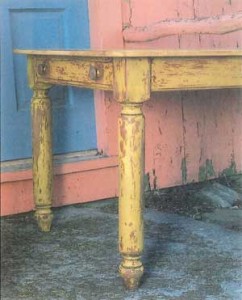 One of the most popular finishes these days is the so-called “shabby chic,” a modern term for what we used to call antique finish. Why would you want to take new furniture and intentionally make it look old? Strange though it may seem, there’s actually a very good reason.
One of the most popular finishes these days is the so-called “shabby chic,” a modern term for what we used to call antique finish. Why would you want to take new furniture and intentionally make it look old? Strange though it may seem, there’s actually a very good reason.
Let’s say you have a spot where an antique would be just the ticket, but not just any antique. You want a certain style of furniture, in just the right color, with the perfect amount and type of wear; not too much, and only worn in the right places. You’d want a piece still in great structural condition that looks as though it was painted years ago, then was gently but regularly used. In other words, something that looks timeworn, but not bereft.
Obviously, finding just the right style and color in an antique would be difficult enough; to then find one worn precisely the amount you want, and with the wear in an artistic pattern, is well nigh impossible. However, it’s quite easy for you to reproduce it.
Typically, we start by staining the raw wood, then sealing it with a clear sealer, such as Zinsser Bullsye® SealCoat™. Once the sealer is dry, paint the whole thing in a solid color (or colors, for the artistic) with acrylic or latex paint. So far, we’ve mimicked a stained “natural” finish that eventually was painted over.
Now, we’ll add years of use. With fine sandpaper, medium nylon abrasive pads, or even steel wool, wear the paint away in those areas it would most likely have worn in actual use. Usually that’s the high points: the edges of raised panels, corners, knuckles on feet and arms, and so on. Wear more or less to your taste, and wherever it looks stylish to you. The sealer will make it easy to wear the paint away, and nicely stained wood will show beneath, imparting a realistic aged look.
You can leave it like that, or add some accumulated “dirt” to the paint with dry brushing, a technique that adds color by glancing over the surface with a brush whose bristle tips have been scrubbed into diluted artist pigment until almost dry. As before, add the “dirt” where you think it would have accumulated. The most realistic colors for this are burnt umber and raw umber. (I’ll explain dry brushing in depth in a future blog.)
Once you have the look you like, let it dry and seal it with a coat of matte or satin water-based polyurethane. One coat of clear should be enough.
There. You’ve done shabby chic. Now you, too, can call yourself a designer.
Michael Dresdner







